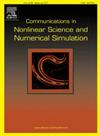High-order mass- and energy-conserving methods for the coupled nonlinear Schrödinger equation
IF 3.4
2区 数学
Q1 MATHEMATICS, APPLIED
Communications in Nonlinear Science and Numerical Simulation
Pub Date : 2025-05-20
DOI:10.1016/j.cnsns.2025.108944
引用次数: 0
Abstract
A novel high-order numerical method, specifically designed to preserve the mass and energy invariants of the coupled nonlinear Schrödinger equation (CNLS) is introduced. This algorithm integrates Gauss collocation schemes for temporal discretization with finite element methods for spatial discretization, enhanced by a post-processing correction procedure that ensures mass and energy conservation at each time step. The theoretical framework for the proposed method rigorously establishes the existence, uniqueness, and high-order convergence of the numerical solutions. In particular, the error of our proposed scheme is proven to converge at the rate of in the -norm, where and denote the temporal and spatial step sizes, respectively, and and represent the degrees of the temporal and spatial finite element approximations, which can be arbitrarily high. The error analysis explicitly accounts for the cumulative effects of the post-processing correction across all time levels. A series of numerical experiments are presented to validate the proposed method, demonstrating its capacity to conserve mass and energy precisely, achieve high-order accuracy, and accurately capture soliton, bi-soliton and plane wave dynamics.
耦合非线性Schrödinger方程的高阶质量和能量节约方法
介绍了一种新的高阶数值方法,该方法专门用于保持耦合非线性Schrödinger方程(CNLS)的质量和能量不变量。该算法将时间离散化的高斯配置方案与空间离散化的有限元方法相结合,并通过后处理校正程序增强,确保每个时间步的质量和能量守恒。该方法的理论框架严格地建立了数值解的存在性、唯一性和高阶收敛性。特别地,我们提出的方案的误差被证明在L∞(0,T;H1)范数上以O(τk+1+hp)的速率收敛,其中τ和h分别表示时间和空间步长,k和p表示时间和空间有限元近似的程度,其可以任意高。误差分析明确地说明了所有时间级别的后处理校正的累积效应。通过一系列数值实验验证了该方法的有效性,证明了该方法能够精确地保存质量和能量,实现高阶精度,并能准确地捕获孤子、双孤子和平面波动力学。
本文章由计算机程序翻译,如有差异,请以英文原文为准。
求助全文
约1分钟内获得全文
求助全文
来源期刊

Communications in Nonlinear Science and Numerical Simulation
MATHEMATICS, APPLIED-MATHEMATICS, INTERDISCIPLINARY APPLICATIONS
CiteScore
6.80
自引率
7.70%
发文量
378
审稿时长
78 days
期刊介绍:
The journal publishes original research findings on experimental observation, mathematical modeling, theoretical analysis and numerical simulation, for more accurate description, better prediction or novel application, of nonlinear phenomena in science and engineering. It offers a venue for researchers to make rapid exchange of ideas and techniques in nonlinear science and complexity.
The submission of manuscripts with cross-disciplinary approaches in nonlinear science and complexity is particularly encouraged.
Topics of interest:
Nonlinear differential or delay equations, Lie group analysis and asymptotic methods, Discontinuous systems, Fractals, Fractional calculus and dynamics, Nonlinear effects in quantum mechanics, Nonlinear stochastic processes, Experimental nonlinear science, Time-series and signal analysis, Computational methods and simulations in nonlinear science and engineering, Control of dynamical systems, Synchronization, Lyapunov analysis, High-dimensional chaos and turbulence, Chaos in Hamiltonian systems, Integrable systems and solitons, Collective behavior in many-body systems, Biological physics and networks, Nonlinear mechanical systems, Complex systems and complexity.
No length limitation for contributions is set, but only concisely written manuscripts are published. Brief papers are published on the basis of Rapid Communications. Discussions of previously published papers are welcome.
 求助内容:
求助内容: 应助结果提醒方式:
应助结果提醒方式:


